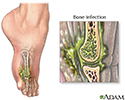Osteomyelitis in children
Bone infection - children; Infection - bone - children
Osteomyelitis is a bone infection caused by bacteria or other germs.
Causes
A bone infection is most often caused by bacteria. It can also be caused by fungi or other germs. In children, the long bones of the arms or legs are most often involved.
When a child has osteomyelitis:
- Bacteria or other germs may spread to the bone from infected skin, muscles, or tendons next to the bone. This may occur under a skin sore.
- The infection can start in another part of the body and spread through the blood to the bone.
- The infection can be caused by an injury that breaks the skin and bone (open fracture). Bacteria can enter the skin and infect the bone.
- The infection can also start after bone surgery. This is more likely if the surgery is done after an injury, or if metal rods or plates are placed in the bone.
Other risk factors include:
- Premature birth or delivery complications in newborns
- Diabetes
- Poor blood supply
- Recent injury
- Sickle cell disease
- Infection due to a foreign body
- Pressure ulcers
- Human bites or animal bites
- Weak immune system
Symptoms
Osteomyelitis symptoms include:
- Bone pain
- Excessive sweating
- Fever and chills
- General discomfort, uneasiness, or ill feeling (malaise)
- Local swelling, redness, and warmth
- Pain at the infection site
- Swelling of the ankles, feet, and legs
- Refusing to walk (when leg bones are involved)
Infants with osteomyelitis may not have a fever or other signs of illness. They might avoid moving the infected limb due to pain.
Exams and Tests
Your child's health care provider will perform a physical examination and ask about the symptoms your child is having.
Tests that your child's provider may order include:
- Blood cultures
- Bone biopsy (the sample is cultured and examined under a microscope)
- Bone scan
- Bone x-ray
- Complete blood count (CBC)
- C-reactive protein (CRP)
- Erythrocyte sedimentation rate (ESR)
- MRI of the bone
- Needle aspiration of the area of the affected bones
Treatment
The goal of treatment is to stop the infection and reduce damage to the bone and surrounding tissues.
Antibiotics are given to destroy the bacteria causing the infection:
- Your child may receive more than one antibiotic at a time.
- Antibiotics are taken for at least 4 to 6 weeks, often at home through an IV (intravenously, meaning through a vein).
Surgery may be needed to remove dead bone tissue if the child has an infection that does not go away.
- If there are metal plates near the infection, they may need to be removed.
- The open space left by the removed bone tissue may be filled with bone graft or packing material. This promotes the growth of new bone tissue.
If your child was treated in the hospital for osteomyelitis, be sure to follow the provider's instructions on how to care for your child at home.
Outlook (Prognosis)
With treatment, the outcome for acute osteomyelitis is usually good.
The outlook is worse for those with long-term (chronic) osteomyelitis. Symptoms may come and go for years, even with surgery.
When to Contact a Medical Professional
Contact your child's provider if:
- Your child develops symptoms of osteomyelitis
- Your child has osteomyelitis and the symptoms continue, even with treatment
References
Dabov GD. Osteomyelitis. In: Azar FM, Beaty JH, Canale ST, eds. Campbell's Operative Orthopaedics. 14th ed. Philadelphia, PA: Elsevier; 2021:chap 21.
Krogstad P. Osteomyelitis. In: Cherry JD, Harrison GJ, Kaplan SL, Steinbach WJ, Hotez PJ, eds. Feigin and Cherry's Textbook of Pediatric Infectious Diseases. 8th ed. Philadelphia, PA: Elsevier; 2019:chap 55.
Robinette E, Shah SS. Osteomyelitis. In: Kliegman RM, St. Geme JW, Blum NJ, Shah SS, Tasker RC, Wilson KM, eds. Nelson Textbook of Pediatrics. 21st ed. Philadelphia, PA: Elsevier; 2020:chap 704.
Review Date: 9/10/2022

















